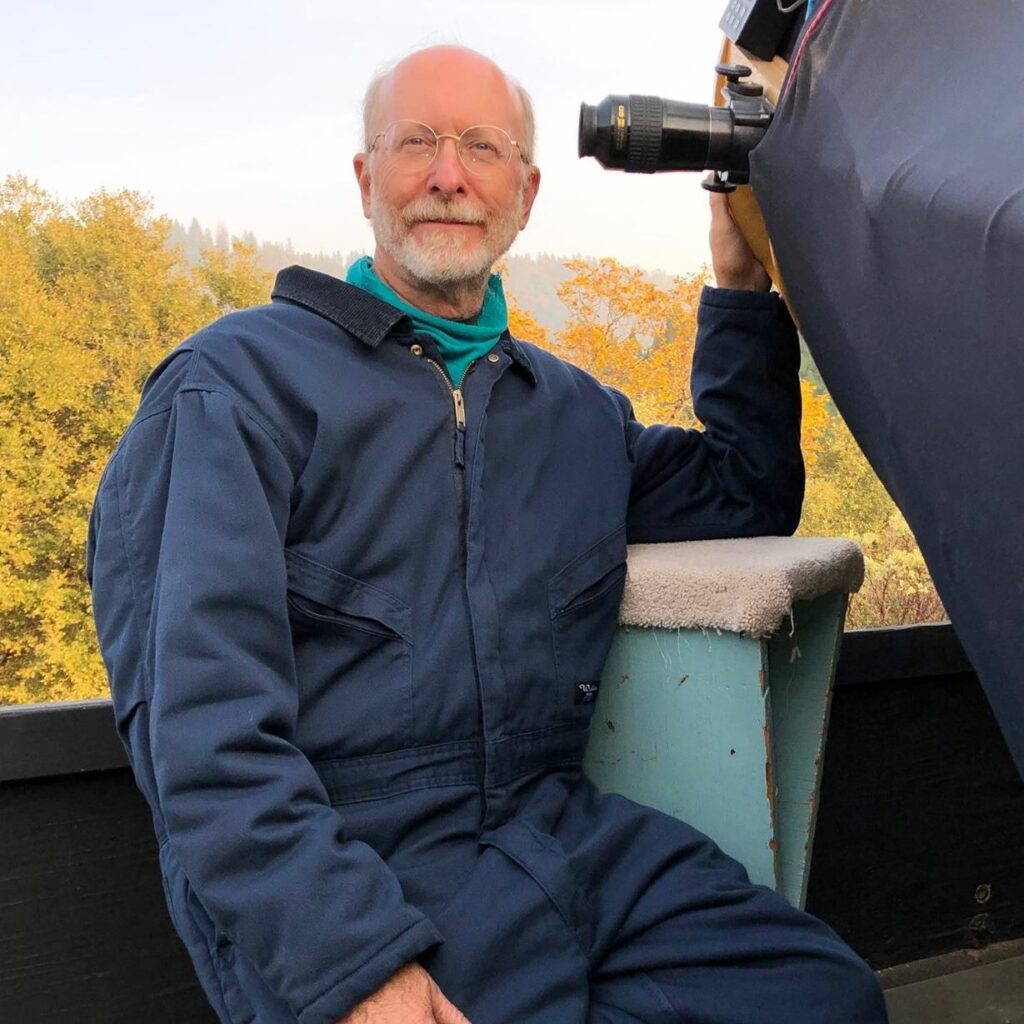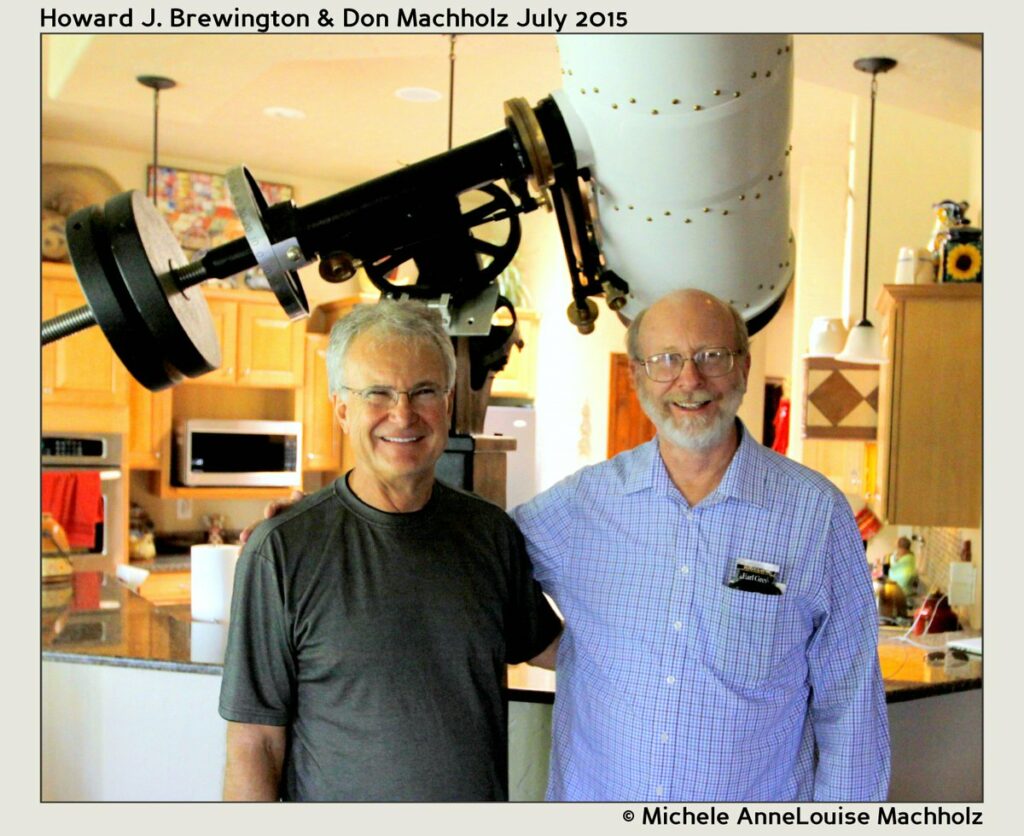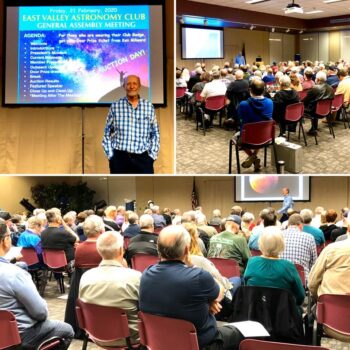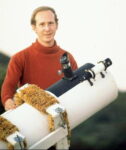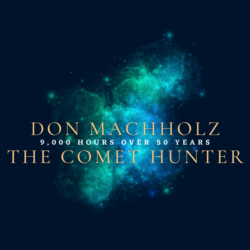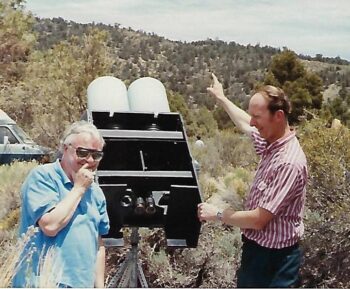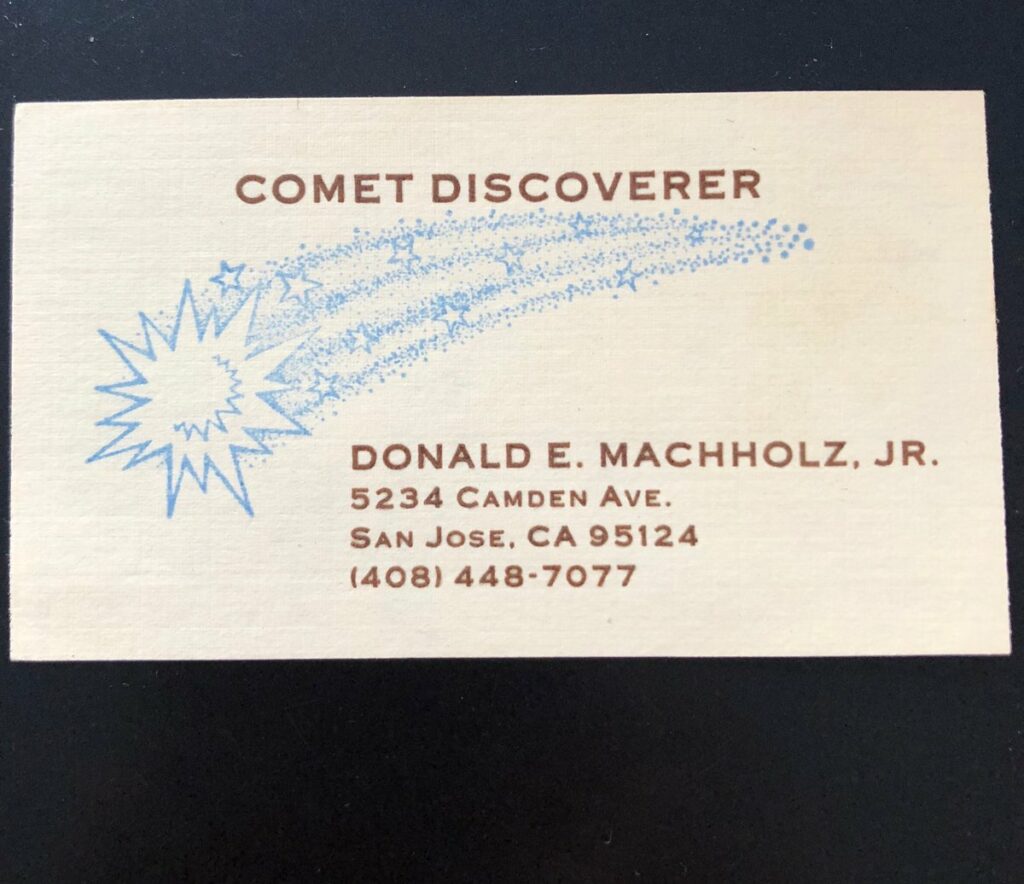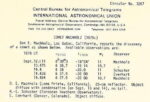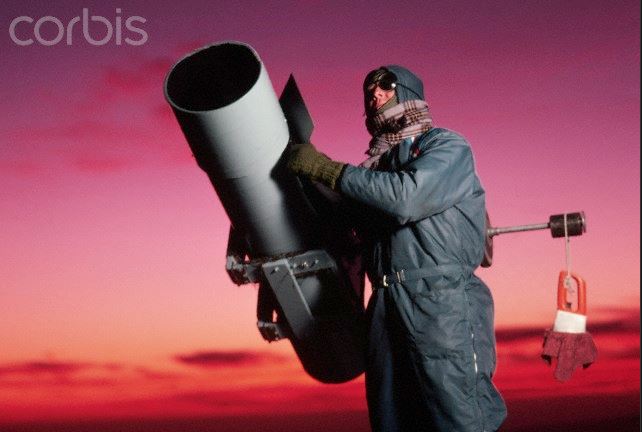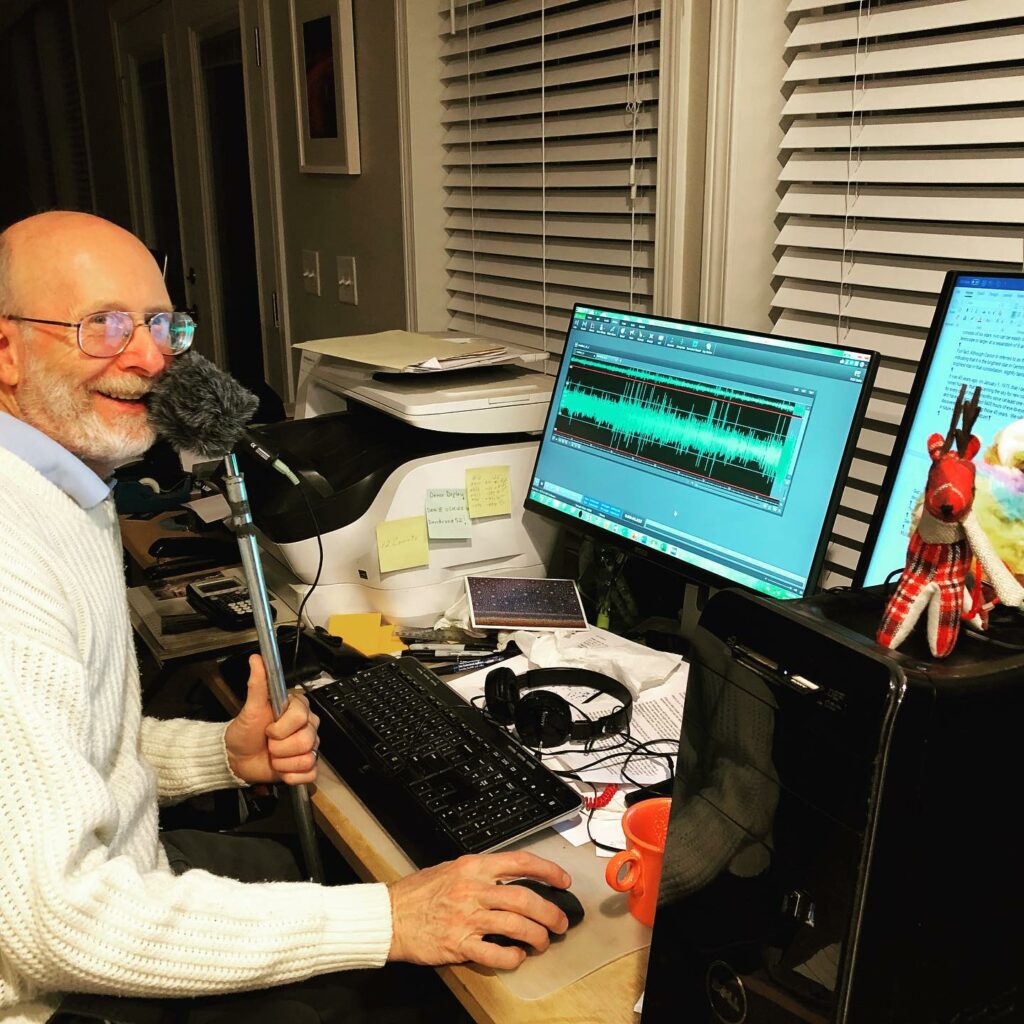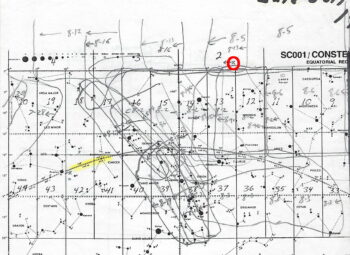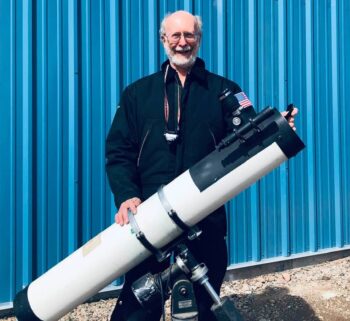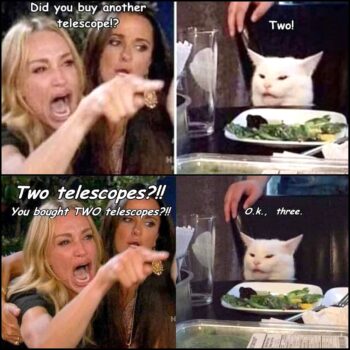The Discovery of Periodic Comet 141P/Machholz 2
August 13, 1994
By Don Machholz
It’s always interesting to find an unusual comet. You not only have the satisfaction and joy of discovering a new comet but the series of surprises that follow. Such a comet is the “gift that keeps on giving”. This was the situation for me during the appearance of Periodic Comet Machholz 2 in August 1994.
On July 6, 1994, I discovered a comet in the north polar part of the sky. In the five weeks since then, I had been out comet hunting for 46.5 hours in 21 sessions. This was my eleventh comet hunting session of August, the fourteenth in seventeen days.

The above map shows the areas that I covered during this time. The yellow bar is the position of the sun during the month from full moon to full moon. Enclosed pencil drawings are the areas that I covered with the dates that I covered each one written inside. The evening sky is on the far left and the morning near the center. The comet’s position on August 13 is indicated by a circle near the top.
On Saturday, August 13, my wife and two sons had been gone for most of the week, visiting my wife’s family in San Jose. I was working as an electronic technician five days a week in Rancho Cordova. At the same time, I was writing a book about the Messier Marathon. I have a notebook in my folder for this comet with notes to myself of things to do. Every day I picked up the mail and fed the pets, and as I neared Saturday house cleaning chores crept into my list. And nearly every night I went comet hunting, allowing only about 3-4 hours of sleep per night. It was a busy week.
On the evening of August 12, I swept the evening sky for 1.25 hours, then went to bed by 11 PM. A few hours later I awoke at about 2 AM (Saturday, August 13) for a short time of meteor watching for the Perseids, which I did in a sleeping bag in a lawn chair near the observatory. At 2:56 AM PDT, after 16 minutes of sweeping a polar region, I picked up a faint fuzzy object. I was using my 10″ (25cm) reflector telescope at 36x, derived by using a 32mm eyepiece with a minus 4 diopter negative lens pressed into the eyepiece barrel to increase the magnification slightly, as a Barlow lens. The scope is mounted on an English Fork mount in my observatory in Colfax, CA.
I knew almost immediately that this was a comet. It appeared diffuse with some condensation, and I knew that no clusters, nebulae, or galaxies in the area. I went southward to find open cluster NGC 1502 to confirm my location. The discovery location was near a star asterism, a string of stars known as Kemble’s Cascade”. The song “Ooo Baby Baby” by Linda Ronstadt was playing on the radio.
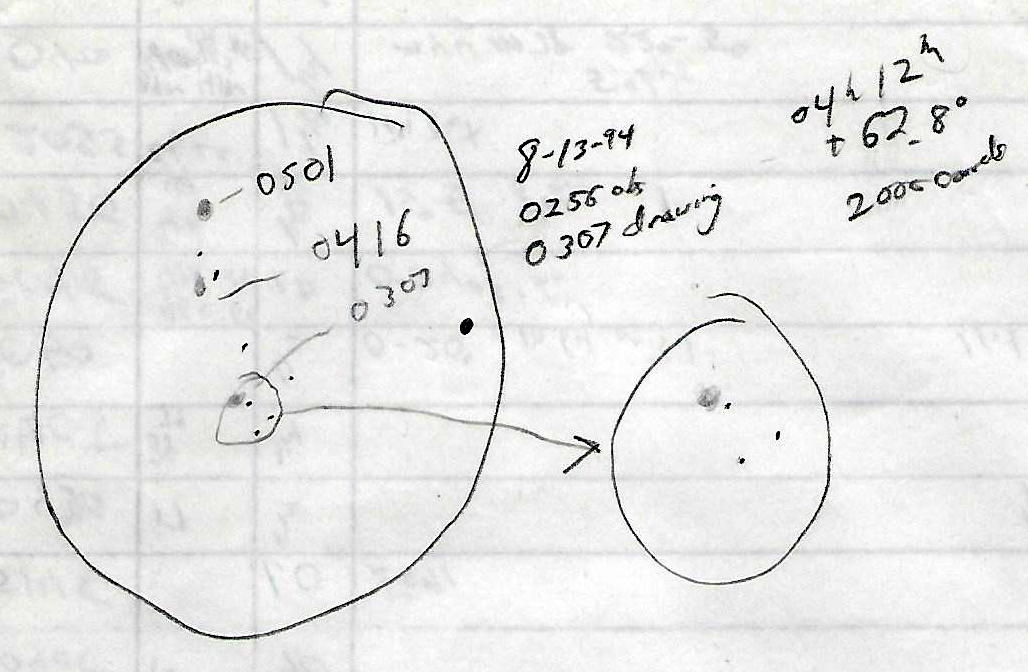
After double-checking my star charts, roughing out a position, and making a drawing for motion, I went into the house, booted up my old IBM 286 computer, connected to the Smithsonian Astrophysical Observatory, and used their scanning service to see if any known comets were in that area. None were. So, I sent them this message:
“I am presently checking out a cometary object at 04h 12m,
+63.8 degrees, mag. 10.5. More later. Don Machholz”

Note that I made an error in the message and was off by one degree in the declination, (63.8 rather than 62.8) that was later corrected. I then returned to the telescope and noticed that the comet had indeed moved slightly. Over the next two hours, I plotted its position, in addition to continuing my comet hunting of the polar region.
At twilight, I took one last look at the comet, then came back into the house and transmitted three positions for it to the SAO on their teletype machine and also phoned Dan Green’s phone number and left a message (Dr. Marsden was in Europe). The comet was moving greater than two degrees per day. It also changed in appearance during this time, becoming more diffuse.
With now a little “free” time, I went to bed for 90 minutes. I was up again when I received a phone call from Gareth Williams saying he would ask Japan to try to confirm the comet. At 8 AM I called my wife in San Jose and let her know about the comet discovery, followed by two phone calls to fellow amateur astronomers in the San Jose area. Then I set about doing chores around the house and wrote up a short summary describing my Messier Marathon book, not yet finished. I then called a member of the San Jose Astronomical Association, which would be holding a star party that night, to give them the coordinates of the comet. They ended up publishing it on their bulletin board, a move that Dr. Marsden would later warn me could have cost me the comet, as no one is to publicize a comet’s position in those days before it was confirmed and officially announced by the Smithsonian.
At 1:20 Dan Green of the Smithsonian called me to say they would issue a circular announcing the discovery of the comet based only on my observation. But before that was issued, a confirmation from Japan arrived and was placed into the announcement.
Circular No. 6053
Central Bureau for Astronomical Telegrams
INTERNATIONAL ASTRONOMICAL UNION
Postal Address: Central Bureau for Astronomical Telegrams
Smithsonian Astrophysical Observatory, Cambridge, MA 02138, U.S.A.
Telephone 617-495-7244/7440/7444 (for emergency use only)
TWX 710-320-6842 ASTROGRAM CAM EASYLINK 62794505
MARSDEN@CFA or GREEN@CFA (.SPAN, .BITNET or .HARVARD.EDU)
COMET MACHHOLZ (1994o)
Donald E. Machholz reports his visual discovery of a comet.
The following observations are available:
1994 UT R.A. (2000) Decl. m1 Observer
Aug. 13.4215 4 12.9 +62 48 10 Machholz
13.80190 4 20 30.42 +62 37 18.1 Kojima
13.80304 4 20 31.66 +62 37 18.1 “
13.80431 4 20 33.44 +62 37 18.6 “
13.80535 4 20 35.32 +62 37 11.6 “
D. E. Machholz (Colfax, CA). 0.25-m reflector. Comet diffuse with little condensation; coma diameter perhaps 3′-4′.
T. Kojima (YGCO Chiyoda Observatory). 0.25-m reflector + CCD. Poor conditions in the twilight. Comet diffuse with condensation.
Communicated by S. Nakano, Sumoto, Japan.
1994 August 13 (6053) Daniel W. E. Green
This comet find was 46.5 search hours and 21 sessions since my previous find on July 6, 1994. A week before this find, this comet passed 5.2 degrees from that one. This was the third comet discovery with my 10-inch reflector and my fourth find from Colfax. This was also my second find within five weeks, and within two months I would discover yet another comet.
As shown in the map at the beginning of this story, I swept north of the area that the comet was passing through on August 5. On that morning the comet was at RA: 01h 23m, Dec: +59.5 degrees. The area that I covered with the 10-inch reflector ranged from 90 degrees declination to 60 degrees declination, from RA 0 Hours to 5 Hours. I usually over-spill the declination, going as far south as 58 degrees or so, and with the equatorial mount sweeping northward only half-way to the north pole every other sweep. This gives me plenty of overlap. In that session, I picked up a few faint galaxies, but not the comet. Why not? Three possibilities exist. Perhaps I did not sweep far south enough to hit the area that it was in. Or since it was only 50 arcminutes south of a bright star (Delta Cassiopeiae, magnitude 2.66), the field was dazzled by the star. Or perhaps the comet was too faint, and either brightened rapidly or outburst shortly before I discovered it a week later.
The next morning, August 6, I covered the area south of the comet. That too is shown on the map at the beginning of this story. I picked up several faint galaxies with the 10-inch reflector. By then the comet was at RA: 01h 42m, Dec: +60 .6 degrees. Why did I not discover the comet then? As with August 5, we have factors 1 and 3 above. Factor #2 does not apply because the comet was now 2 degrees from the bright star, so that would not have been a factor on August 6. The fact that I missed the comet on two consecutive mornings would seem to indicate it might have simply been too faint to be discovered, which would mean it was probably fainter than magnitude 11.5.
More information was released about this comet. The comet is periodic, it returns every six years. This is reflected in the following Circular.
Circular No. 6059
PERIODIC COMET MACHHOLZ 2 (1994o)
Additional observations have shown that this comet is of short period, meaning that comet 1986 VIII = 1991 XII now becomes P/Machholz 1. The following orbital elements are from MPEC 1994-Q06:
T = 1994 Sept.17.821 TT Peri. = 147.547
e = 0.79054 Node = 247.484 2000.0
q = 0.75272 AU Incl. = 13.266
a = 3.59366 AU n = 0.144677 P = 6.81 years
1994 TT R. A. (2000) Decl. Delta r Elong. Phase m1
Aug. 26 7 03.48 +49 41.7 0.417 0.851 56.0 100.0 9.9
28 7 17.83 +47 14.0 0.434 0.836 54.4 100.6 9.9
30 7 30.32 +44 49.9 0.453 0.821 53.0 100.8 9.9
Sept. 1 7 41.36 +42 30.6 0.473 0.808 51.9 100.7 9.9
3 7 51.24 +40 16.5 0.494 0.796 51.0 100.3 10.0
5 8 00.21 +38 07.7 0.515 0.786 50.2 99.6 10.0
7 8 08.46 +36 04.3 0.537 0.776 49.6 98.6 10.1
9 8 16.14 +34 06.0 0.560 0.769 49.2 97.4 10.1
11 8 23.35 +32 12.6 0.583 0.762 48.9 96.0 10.1
13 8 30.18 +30 23.9 0.607 0.758 48.6 94.4 10.2
15 8 36.72 +28 39.6 0.631 0.754 48.5 92.7 10.3
17 8 43.01 +26 59.4 0.655 0.753 48.5 90.8 10.3
19 8 49.09 +25 23.1 0.680 0.753 48.5 88.9 10.4
21 8 55.00 +23 50.3 0.704 0.755 48.6 86.9 10.5
23 9 00.77 +22 21.0 0.729 0.758 48.8 84.8 10.6
25 9 06.40 +20 54.8 0.754 0.763 49.0 82.8 10.7
1994 August 23 (6059) Daniel W. E. Green
The comet made a close approach to earth in January 1979, within 25 million miles. Could it have been discovered at that time? Possibly the comet did not turn on its brightness until 1994 so it wasn’t very bright in 1979. At that time, I was comet hunting from Loma Prieta, in the Santa Cruz Mountains, in California. The instrument I was using was my 10-inch reflector. During evening sweeps on October 22, 1978, six weeks after I had found my first comet, I swept over the comet and did not see it. It would have been 27 degrees high in my southwestern sky and slightly more than 1 AU from both the earth and the sun. I would expect the absolute and apparent magnitude would have been fainter than 11 at that time, for me to not see it. On the evening of November 23, 1978, I swept over it, not seeing it, when it was about 8 degrees above my southwestern horizon. On December 19, 1978, I swept over it and missed it when it was 19 degrees above my southwestern horizon. On December 23, 1978, I swept the area that it was in and failed to see it. It was 13 degrees high in my southwestern sky. So, on four occasions I swept over it without seeing it. My southwestern horizon did have some light pollution in the southwestern sky caused by Santa Cruz and the Monterey Bay area, but that alone could not explain missing it four times when, if it had behaved as it did in 1994, it would have been between magnitude 10.3 in late October to magnitude 8.1 by December 23.
The next three occasions were dates when I swept areas near the comet but did not reach the comet’s position. On January 22, 1979, the comet was in the evening sky, 02h 38m, -04 degrees, and that evening I swept the areas to the west of it, stopping at 02h 00m RA. On February 16, 1979, I again swept areas west of the comet; the comet was at 05h 12m, +02 degrees, and I swept up to 04h 00m RA. Likewise, on March 30 I stopped sweeping about 20 degrees short of the comet’s position. On May 13, 1979, I swept over the comet but did not see it. By then it was more than two AUs from both the earth and the sun, and faint.
Now back to 1994. By this time, I had also heard that the comet had brightened. This occurred while the comet was in moonlit skies, and not observed by me, but others saw and imaged it.
Circular No. 6067
PERIODIC COMET MACHHOLZ 2 (1994o)
The primary component of this comet has evidently brightened since discovery. P. Pravec reports that 120-s CCD images taken through a 2′ aperture by M. Wolf and L. Sarounova with the Ondrejov 0.65-m reflector (+ V filter) show that the total brightness was about 2-3 mag brighter on Aug. 23.07 UT than on Aug. 15.92 and 16.90.
Total visual magnitude estimates (cf. IAUC 6057):
Aug. 19.07 UT, 8.2 (L. Szentasko, Veresegyhaz, Hungary, 0.33-m reflector);
23.09, 7.8 (J. Lancashire, Cambridge, England, 10×80 binoculars);
28.12, 8.6 (H. Mikuz, Ljubljana, Slovenia, 0.20-m f/2 Baker-Schmidt camera + V filter + ST-6 CCD);
28.36, 7.7 (J. E. Bortle, Stormville, NY, 20×80 binoculars);
30.36, 7.6 (Bortle).
1994 August 30 (6067) Daniel W. E. Green
So, the periodic comet has outburst. That should keep us busy for a while. Are there any more surprises from this comet? This Circular nearly knocked my socks off.
Circular No. 6066
PERIODIC COMET MACHHOLZ 2 (1994o)
H. Luthen, Hamburg, reports the discovery by Michael Jager of a second comet in the field of comet 1994o, located about 48′ to the northeast of 1994o and appearing to have the same motion as comet 1994o. Additional observations have been reported in response to requests for confirmation from the Bureau:
1994 UT R.A. (2000) Decl. m1 Observer
Aug. 28.03611 7 19.2 +47 53 11 Jager
30.05970 7 31 53.75 +45 24 44.1 Varady
30.09678 7 32 06.78 +45 22 04.5 12.1 “
30.09861 7 32.2 +45 21 Jager
30.46925 7 34 15.52 +44 55 07.2 Balam
30.51247 7 34 30.46 +44 51 59.3 “
M. Jager (Vienna, Austria). 0.20-m Schmidt camera + 2415 Tech Pan film. Diffuse coma 4′-5′ in diameter, with little or no condensation.
M. Varady and P. Pravec (Ondrejov). 0.65-m f/3.6 reflector + CCD. Comet has moderate central condensation; m2 = 16.3; coma diameter 2′.2, with a faint halo of diameter 3′.5.
D. D. Balam (Climenhaga Observatory, Victoria). 0.5-m reflector + CCD. Comet very diffuse, with no central condensation; difficult to measure.
1994 August 30 (6066) Daniel W. E. Green
A third component was then found, followed by two more:
Circular No. 6071
PERIODIC COMET MACHHOLZ 2 (1994o)
P. Pravec, Ondrejov, reports his discovery of fourth and fifth components to this comet on CCD images obtained with the 0.65-m reflector on Sept. 4.1 UT. The fourth component — also independently reported by W. Johnson (Anza, CA), by T. Puckett, J. Armstrong, and M. Marcus (Atlanta, GA), and by M. Jager (Vienna, Austria) – was then similar in brightness to the third component (IAUC 6070), about a magnitude fainter than the second component (IAUC 6066), sporting a 2′.0 coma with little condensation, and located some 320″ north-northeast of the primary component. The fifth fragment (also evidently found by Jager on his films) was nearly 1 mag fainter than the fourth component, consisted of a 1′-2′ diffuse coma and little or no condensation, and was located 307″ north-northeast of the second component.
1994 September 6 (6071) Daniel W. E. Green
The orbit was refined, yielding a very short period of 5.231 years.
Circular No. 6081
PERIODIC COMET MACHHOLZ 2 (1994o)
Improved orbital elements from MPC 23956:
T = 1994 Sept.18.8010 TT Peri. = 149.2566
e = 0.750261 Node = 246.1808 2000.0
q = 0.752551 AU Incl. = 12.7877
a = 3.013353 AU n = 0.1884209 P = 5.231 years
1994 TT R. A. (2000) Decl. Delta r Elong. Phase m1
Sept. 25 9 06.69 +20 55.9 0.731 0.760 49.0 84.5 8.0
30 9 20.42 +17 33.2 0.791 0.777 49.7 79.4 8.3
Oct. 5 9 33.52 +14 26.7 0.848 0.802 50.6 74.6 8.7
10 9 45.99 +11 34.4 0.902 0.834 51.7 70.1 9.1
15 9 57.83 + 8 54.8 0.953 0.873 53.1 66.0 9.5
20 10 09.01 + 6 26.4 1.000 0.916 54.7 62.4 9.9
25 10 19.50 + 4 08.1 1.042 0.964 56.4 59.3 10.3
30 10 29.29 + 1 59.0 1.080 1.014 58.4 56.5 10.8
Nov. 4 10 38.37 – 0 01.8 1.113 1.067 60.6 54.1 11.2
9 10 46.70 – 1 54.9 1.141 1.121 63.0 51.9 11.5
14 10 54.29 – 3 40.9 1.165 1.176 65.6 50.0 11.9
19 11 01.11 – 5 20.2 1.185 1.232 68.4 48.2 12.2
24 11 07.16 – 6 53.4 1.200 1.288 71.4 46.6 12.5
The orbital elements and ephemeris above refer to the principal nucleus, designated component A. Components B, C, D, and E are designated in order eastward from component A and are thus the fourth, third, second, and fifth components, respectively, mentioned on IAUC 6071, 6070, 6066, and 6071. Their positions can be described well with the above orbital elements, provided that T is changed to Sept. 18.866, 19.199, 19.206, and 19.267, respectively.
The total visual magnitude and coma-diameter estimates of component B (cf. IAUC 6071):
Sept. 9.45 UT, 12.0, 2′ (R. A. Keen, Mount Thorodin, CO, 0.32-m reflector);
11.51, 11.9, 1′.4 (C. S. Morris, Pine Mountain Club, CA, 0.26-m reflector).
Total visual magnitude and coma-diameter estimates of component D (cf. IAUC 6074):
Sept. 9.45 UT, 11.0, 3′ (Keen);
11.48, 11.3, 3′.3 (Morris).
1994 September 21 (6081) Daniel W. E. Green
Finally, as if this wasn’t enough, Component A dimmed and Component D brightened, presenting us with a double comet within the same field of view.
Circular No. 6082
PERIODIC COMET MACHHOLZ 2 (1994o)
Several observers have reported that the primary component (A) of this comet has become diffuse and much fainter in the past week, while component D has brightened and become much more condensed. Total visual magnitude estimates of component A (cf. IAUC 6075):
Sept. 17.13 UT, 7.6 (A. Diepvens, Balen, Belgium, 0.15-m refractor);
24.50, 9.0 (C. S. Morris, Pine Mountain Club, CA, 0.26-m reflector);
25.49, 9.0 (Morris; 4′.4 coma);
25.83, 9.4 (J. Kobayashi, Kumamoto, Japan, 0.41-m reflector).
Total visual magnitude estimates of component D (cf. IAUC 6081): Sept. 16.09 UT, 9.7 (L. Szentasko, Veresegyhaz, Hungary, 0.33-m reflector);
24.50, 8.8 (Morris);
25.50, 8.6 (Morris; 2′.9 coma);
25.83, 9.0 (Kobayashi).
1994 September 26 (6082) Daniel W. E. Green
In late September I had a memorable view of this comet, a double comet with each one being magnitude 9, in the same field of view. This reminded me at the time of the now-lost Comet Biela, which in 1846 also had a double comet appearance.
This was a most unusual comet.
End.




